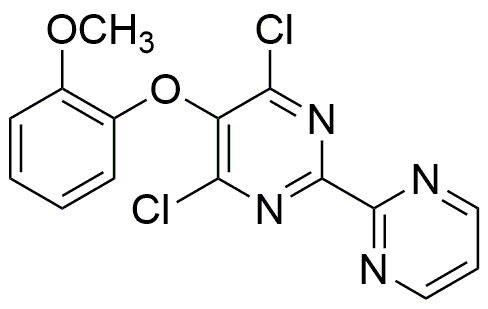4,6-Dichloro-5-(2-methoxyphenoxy)-2,2'-bipyrimidine is widely utilized in research focused on:
- Agricultural Chemistry: This compound serves as an effective herbicide, helping to control unwanted plant growth in various crops, thus improving yield and quality.
- Pharmaceutical Development: It is explored for its potential in developing new medications, particularly in targeting specific biological pathways, which can lead to innovative treatments.
- Material Science: The compound is used in the synthesis of advanced materials, contributing to the development of coatings and polymers with enhanced properties.
- Environmental Science: It plays a role in studies assessing soil and water contamination, aiding in the development of remediation strategies for polluted environments.
- Analytical Chemistry: This chemical is utilized as a standard in various analytical methods, ensuring accurate measurements and results in laboratory settings.
Informations générales
Propriétés
Sécurité et réglementation
Applications
4,6-Dichloro-5-(2-methoxyphenoxy)-2,2'-bipyrimidine is widely utilized in research focused on:
- Agricultural Chemistry: This compound serves as an effective herbicide, helping to control unwanted plant growth in various crops, thus improving yield and quality.
- Pharmaceutical Development: It is explored for its potential in developing new medications, particularly in targeting specific biological pathways, which can lead to innovative treatments.
- Material Science: The compound is used in the synthesis of advanced materials, contributing to the development of coatings and polymers with enhanced properties.
- Environmental Science: It plays a role in studies assessing soil and water contamination, aiding in the development of remediation strategies for polluted environments.
- Analytical Chemistry: This chemical is utilized as a standard in various analytical methods, ensuring accurate measurements and results in laboratory settings.
Documents
Fiches de données de sécurité (FDS)
La FDS fournit des informations de sécurité complètes sur la manipulation, le stockage et l’élimination du produit.
Spécifications du produit (PS)
Le PS fournit une description complète des propriétés du produit, notamment sa composition chimique, son état physique, sa pureté et les exigences de stockage. Il détaille également les plages de qualité acceptables et les applications prévues du produit.
Certificats d'analyse (COA)
Recherchez des certificats d'analyse (COA) en saisissant le numéro de lot du produit. Les numéros de lot et de lot se trouvent sur l'étiquette d'un produit, après les mots « Lot » ou « Lot de fabrication ».
Numéro de catalogue
Numéro de lot/série
Certificats d'origine (COO)
Ce certificat d'exploitation confirme le pays dans lequel le produit a été fabriqué, et détaille également les matériaux et composants utilisés et s'il est issu de sources naturelles, synthétiques ou autres sources spécifiques. Ce certificat peut être requis pour les douanes, le commerce et la conformité réglementaire.
Numéro de catalogue
Numéro de lot/série
Fiches de données de sécurité (FDS)
La FDS fournit des informations de sécurité complètes sur la manipulation, le stockage et l’élimination du produit.
DownloadSpécifications du produit (PS)
Le PS fournit une description complète des propriétés du produit, notamment sa composition chimique, son état physique, sa pureté et les exigences de stockage. Il détaille également les plages de qualité acceptables et les applications prévues du produit.
DownloadCertificats d'analyse (COA)
Recherchez des certificats d'analyse (COA) en saisissant le numéro de lot du produit. Les numéros de lot et de lot se trouvent sur l'étiquette d'un produit, après les mots « Lot » ou « Lot de fabrication ».
Numéro de catalogue
Numéro de lot/série
Certificats d'origine (COO)
Ce certificat d'exploitation confirme le pays dans lequel le produit a été fabriqué, et détaille également les matériaux et composants utilisés et s'il est issu de sources naturelles, synthétiques ou autres sources spécifiques. Ce certificat peut être requis pour les douanes, le commerce et la conformité réglementaire.


